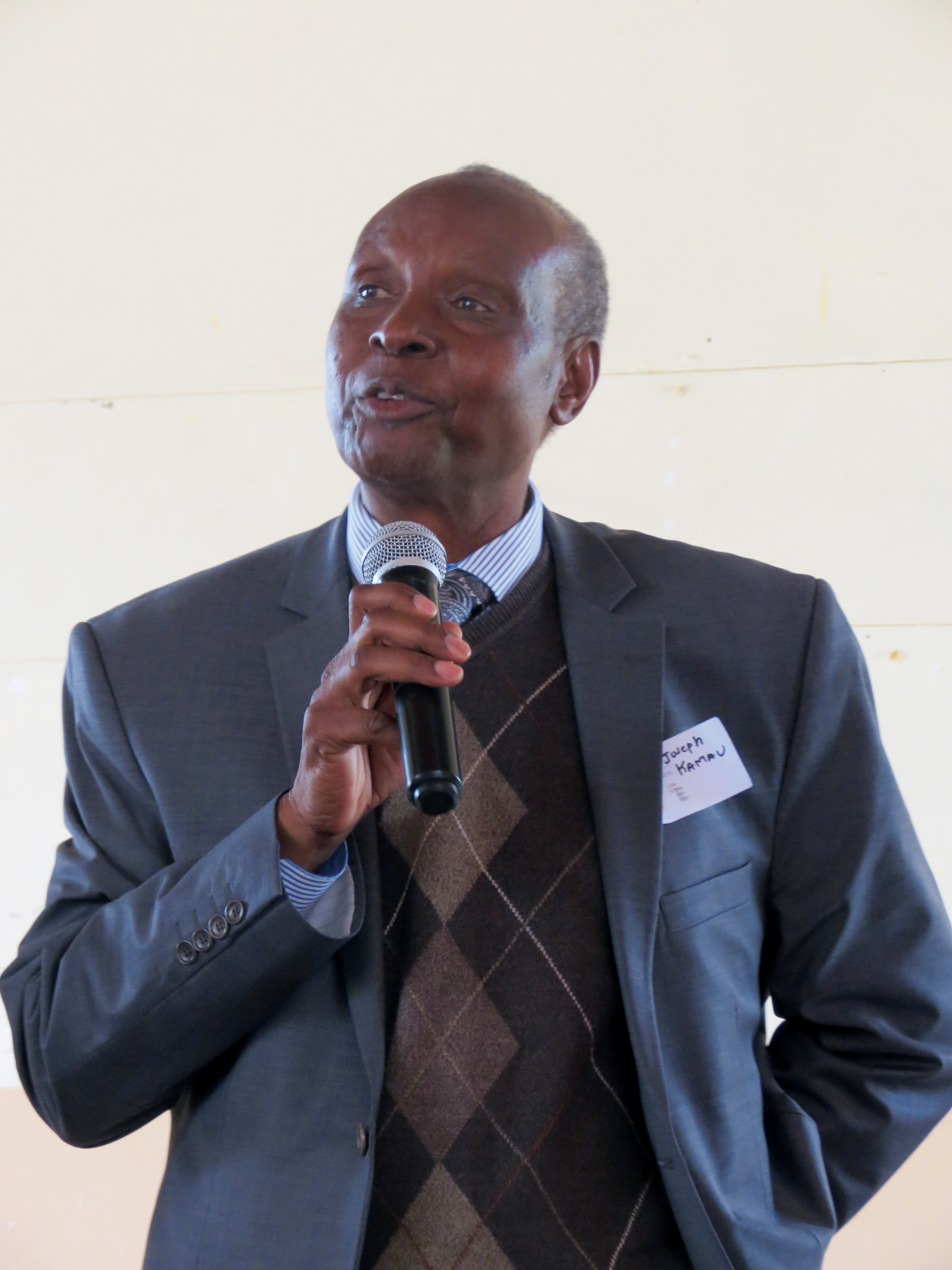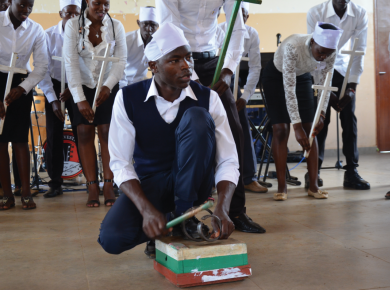Posted: January 14, 2019
 “In the last days it will be, God declares, that I will pour out my Spirit upon all flesh, and your sons and your daughters shall prophesy, and your young men shall see visions, and your old men shall dream dreams” (Acts 2:17).
“In the last days it will be, God declares, that I will pour out my Spirit upon all flesh, and your sons and your daughters shall prophesy, and your young men shall see visions, and your old men shall dream dreams” (Acts 2:17).
Bishop Kisare was sitting by the great tree where the first Mennonite missionaries had embarked by dhow 70 years ago.
I asked the dear bishop brother, “What happened here at Katuru Hill those many years ago?”
A couple tears trickled down his cheeks as he responded, “You are referring to the day the fire of God fell on Katuru Hill.
“That day God touched me and began his transforming work in my soul. My calling as a minister of the gospel began that day. That was a day I shall never forget.
“Jesus touched me and transformed me. People bypassed Katuru Hill for the word in the villages was that all who will come near will be burned for the fire of God is burning on Katuru Hill.”
Child evangelists
That was 1942. On that August Sunday the fire of God fell upon the newly developing Mennonite church at Katuru hill in Shirati.
The congregation experienced the convicting fire of God as people wept in repentance throughout the day and into the evening hours. Wilson Ogwada and Nikanor Dhaje, 12-year-old students at the Shirati elementary school, experienced such compassion for those who didn’t know Jesus that they left school to preach the gospel.
They became the first African Mennonite missionaries as they travelled from community to community to proclaim the Word of God. They pressed onward even though beaten at least once. They preached along the Kenya-Tanzania borderlands.
Speed-walking revivalist
In the providence of God, Rebeka Kizinza “Speedy” opened her home on the Kenya border for the Tanzanian emissaries of the gospel. Twenty-four kilometers a day by foot was her normal speed to serve the Lord uninhibited. Through her speed walking, she knit together a relationship between the Kenyan and Tanzanian revivalists.
There is a mystery in the ministry of the Holy Spirit. “The wind blows where it chooses, and you hear the sound of it, but you do not know where it comes from or where it goes. So it is with everyone who is born of the Spirit” (John 3:8), Jesus said. So it was within the East Africa revival fellowship.
Repenting teacher
Those among us who want to know dates and places will probably trace the beginnings of the revival to a high school teacher in Rwanda, Blasio Kigozi, who invested 12 days in prayer and fasting for the outpouring of the Holy Spirit upon the students, staff and faculty.
Blasio came from his room, a transformed man, first asking his wife forgiveness and then convened a meeting of all faculty and staff to announce that the Lord has revealed the need for repentance. The whole school was convicted. The Anglican bishops in Kampala invited Blasio to meet with the bishops and they also were touched with a deep need for repentance. Within six weeks Blasio took ill and died. But his message across East Africa has never ceased.
 Fruit of the revival
Fruit of the revival
The Mennonites were not passed by as the convicting power of the Holy Spirit moved.
The revival moved as a people who loved Jesus and who loved one another. Early on, the leaders gave attention to continuing the revival. In various ways, all the countries of eastern Africa were touched by the revival that still continues today.
1. The revival is centred in Jesus Christ. Regular fellowship meetings are centred in Jesus. Everyone knew that the revivalists loved Jesus. Whether gathering as thousands or only a few, revivalists meet in Jesus’ name and there Jesus meets the fellowship of believers.
2. The confession of sin, repentance and walking in the light of Jesus is paramount. Every gathering includes the confession of sin and the celebration of the cleansing blood of Jesus. 1 John 1:7 summarizes the central commitments of the revival fellowship: “If we walk in the light as he himself is in the light, we have fellowship with one another, and the blood of Jesus his Son cleanses us from all sin.”
3. The revivalists ministered with fervency. They were nicknamed the people inflamed with passion for Jesus, Balokole.
4. The fellowships are communities of joy. They encompass people from tribes and nations all across east Africa, resembling the picture of the church from Acts 2:5–6: “Now there were devout Jews from every nation under heaven living in Jerusalem. And at this sound the crowd gathered and was bewildered, because each one heard them speaking in the native language of each.”
The movement became the most authentic intertribal community in East Africa. Their spirit of inter-community relationship was a key development in encouraging peaceful efforts for healing the political strife in Kenya. They also modelled the principle of receiving and sharing counsel.
Revival works reconciliation
Small teams of Balokole travelled occasionally to South Africa urging a peaceful political resolution. It is amazing how the revival that began with students enlarged its embrace to invite reconciliation even within the most difficult challenges to the way of peace.
As the fellowship grew, many in the West including the USA were profoundly touched by the grace of Christ that was proclaimed by the fellowship. The legalism of Mennonites in the 1930s and 40s was destructive; the grace-filled messages of the East Africa Mennonites was life giving. Fellowships of revivalists spread into several North American communities, bringing encouragement and new life.
People of the Lamb
The East Africa revival fellowship resisted becoming a denominational fellowship. They stayed within the established churches. But that did not mean that the revivalists did not have an identity.
In the midst of the political turmoil in the region of East Africa, the Balokole were recognized as people of peace. They were called the People of the Lamb, people who laid down their lives in their commitment to Jesus.
Very early on in the movement in Kenya and Uganda as well as Burundi and Rwanda, there was turmoil from tribal or international conflict. The revivalists refused to participate in these violent conflicts. Hundreds died bearing witness that Jesus is the Lamb of God.
Several times in Kenya’s tumultuous post-independence history, the Mennonites have stood boldly with the People of the Lamb, declaring that they are committed to the healing of the nations, not the destruction of the nations.
—David W. Shenk is a globalist whose commitment to bearing faithful witness to Christ in our pluralist world has taken him to more than a hundred countries and regions. David is an author, missionary, teacher, preacher, and leader who with his wife Grace have invested especially in peacemaking with Muslims. He was born in East Africa and is a member of Mountville Mennonite Church in Pennsylvania, USA.
He spoke at Renewal 2027 – The Holy Spirit Transforming Us – in Kisumu, Kenya, 21 April 2018. This paper been adapted from his presentation.
This article first appeared in Courier/Correo/Courrier October 2018.

Join the Conversation on Social Media
FacebookTwitterInstagramFlickrYouTube